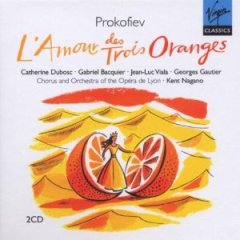Prokofiev - L'Amour des Trois Oranges (Love For Three Oranges) [2006]
Prokofiev - L'Amour des Trois Oranges (Love For Three Oranges) [2006]

Disc 1 1 Prologue 3:44 2 Act 1: Tableau I : Le palais du Roi de Tréfle 9:40 3 Act 1: Tableau II : Lieu cabalistique 3:35 4 Act 1: Tableau III : A la cour du Roi de Tréfle 10:08 5 Act 2: Tableau I : La chambre du Prince 6:48 6 Act 2: Tableau II : La grande cour du palais royal 15:50 Disc 2 1 Act 3: Tableau I : Au desert 9:37 2 Act 3: Tableau II : La cour du chateau de Créonte 7:55 3 Act 3: Tableau III : Au desert 23:06 4 Act 4: Tableau I : Lieu cabalistique 3:33 5 Act 4: Tableau II : Au palais royal 7:48 Jules Bastin (Bass) Gabriel Bacquier (Baritone) Didier Henry (Baritone) Jean-Luc Viala (Tenor) Michele Lagrange (Soprano) Georges Gautier (Tenor) Hélène Parraguin (Mezzo Soprano) Vincent le Texier (Bass Baritone) Gregory Reinhart (Bass), Béatrice Uria-Monzon (Mezzo Soprano) Catherine Dubosc (Soprano) Consuelo Caroli (Mezzo Soprano) Brigitte Fournier (Soprano) Lyon National Opera Orchestra & Chorus Kent Nagano - conductor
A rediscovered masterpiece? Hardly. The music lacks the melodic invention of Prokofiev's mature output, and (perhaps more surprising) the conversational vocal lines are often overlaid on rhythmically static accompaniments. Then, too, the man who composed such highly characterized music for Polina (in The Gambler) and Natasha (in War and Peace) seems baffled by his title character here: the real energy of the opera comes from the submerged, homoerotic interaction between her two lovers, and in the final scene, her music seems like an interruption. But for all its flaws, it's far from negligible: there are hints of specific works to come (premonitions of the First Violin Concerto crop up, for instance, in Stenio's long speech in the third scene) and, more generally, the opera foreshadows Prokofiev's characteristic blend of honey and acid (even though the dark side is consistently more interesting). Thus, for instance, in the dreamy, almost Delian music at the end of scene 1, you can sense (as you never can in Delius) that the dream is hovering on the edge of hallucination. And the opera's power does increase noticeably as the tension between the two men mounts: there's a scorching moment of recognition at the beginning of the fourth scene, and the final confrontation is riveting. The performance is compelling, and except for the unnatural perspective on Maddalena's contributions in the last scene, the sound is quite good. ----- Peter J. Rabinowitz, FANFARE [5/1990]
download: uploaded yandex 4shared mediafire solidfiles mega filecloudio nornar ziddu
Last Updated (Tuesday, 25 March 2014 13:31)








